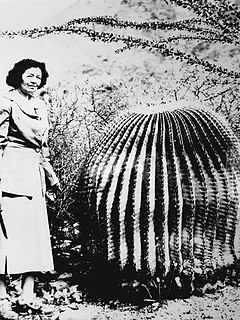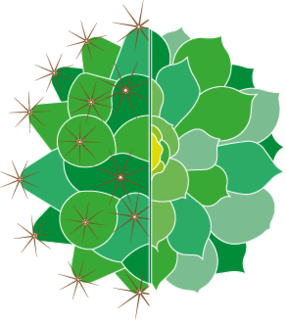Related Research Articles

A cactus is a member of the plant family Cactaceae, a family comprising about 127 genera with some 1750 known species of the order Caryophyllales. The word cactus derives, through Latin, from the Ancient Greek word κάκτος (káktos), a name originally used by Theophrastus for a spiny plant whose identity is now not certain. Cacti occur in a wide range of shapes and sizes. Although some species live in quite humid environments, most cacti live in habitats subject to at least some drought. Many live in extremely dry environments, even being found in the Atacama Desert, one of the driest places on Earth. Because of this, cacti show many adaptations to conserve water. For example, almost all cacti are succulents, meaning they have thickened, fleshy parts adapted to store water. Unlike many other succulents, the stem is the only part of most cacti where this vital process takes place. Most species of cacti have lost true leaves, retaining only spines, which are highly modified leaves. As well as defending against herbivores, spines help prevent water loss by reducing air flow close to the cactus and providing some shade. In the absence of true leaves, cacti's enlarged stems carry out photosynthesis. Cacti are native to the Americas, ranging from Patagonia in the south to parts of western Canada in the north—except for Rhipsalis baccifera, which also grows in Africa and Sri Lanka.

Lithops is a genus of succulent plants in the ice plant family, Aizoaceae. Members of the genus are native to southern Africa. The name is derived from the Ancient Greek words λίθος, meaning "stone," and ὄψ, meaning "face," referring to the stone-like appearance of the plants. They avoid being eaten by blending in with surrounding rocks and are often known as pebble plants or living stones. The formation of the name from the Ancient Greek "-ops" means that even a single plant is called a Lithops.

Echinocactus is a genus of cacti in the subfamily Cactoideae. The generic name derives from the Ancient Greek εχινος (echinos), meaning "spiny," and cactus. It and Ferocactus are the two genera of barrel cactus. Members of the genus usually have heavy spination and relatively small flowers. The fruits are copiously woolly, and this is one major distinction between Echinocactus and Ferocactus. Propagation is by seed.

Desert Botanical Garden is a 140-acre (57 ha) botanical garden located in Papago Park, at 1201 N. Galvin Parkway in Phoenix, central Arizona.

Dudleya, commonly known as liveforevers is a genus of succulent plants in the stonecrop family, Crassulaceae, consisting of about 68 taxa in southwestern North America and Guadalupe Island. The species come in multiple forms, some large and evergreen, others cryptic and deciduous. The flowers of Dudleya have parts numbered in 5, and when fruiting are filled with tiny, ovoid or crescent-shaped seeds.

Bergerocactus emoryi is a species of cactus, known commonly as the golden-spined cereus, golden snake cactus, velvet cactus or golden club cactus. It is a relatively small cactus, but it can form dense thickets or colonies, with the dense yellow spines giving off a velvety appearance when backlit by the sun. From April to May, yellow, green-tinged flowers emerge, which transform into reddish, globular fruit. This species is native to the California Floristic Province, and is found in northwestern Baja California and a small part of California, in San Diego County and on the southern Channel Islands. Where the Mediterranean climate of the California Floristic Province collides with the subtropical Sonoran Desert near El Rosario, hybrids with two other species of cacti are found. It is the sole member of the monotypic genus Bergerocactus, named after German botanist Alwin Berger.
The Arizona Cactus Botanical Garden was a non-profit botanical garden, located at 8 Cactus Lane, Bisbee, Arizona, United States, containing representative samples of over 800 varieties of high desert xerophyte plant life. It was founded by David L. Eppele and has been closed since his death on 19 May 2005.

The Scientific Committee on Antarctic Research (SCAR) is an interdisciplinary body of the International Science Council (ISC). SCAR coordinates international scientific research efforts in Antarctica, including the Southern Ocean.

The California Native Plant Society (CNPS) is a California environmental non-profit organization that seeks to increase understanding of California's native flora and to preserve it for future generations. The mission of CNPS is to conserve California native plants and their natural habitats, and increase understanding, appreciation, and horticultural use of native plants throughout the entire state and California Floristic Province.
CSSA may refer to:

Nong Nooch Tropical Botanical Garden is a 500-acre (2.0 km2) botanical garden and tourist attraction at kilometer 163 on Sukhumvit Road in Chonburi Province, Thailand. It can be reached via bus, taxi or private land transportation. It is also a major scientific center dedicated to cycads, with its own Cycad Gene Bank.
David Richard Hunt was an English botanist and taxonomist. He was a specialist in cacti and the spiderwort family. He notably compiled the 1999 CITES Cactaceae Checklist.

The Desert Garden Conservatory is a large botanical greenhouse and part of the Huntington Library, Art Collections and Botanical Gardens, in San Marino, California. It was constructed in 1985. The Desert Garden Conservatory is adjacent to the 10-acre (40,000 m2) Huntington Desert Garden itself. The Garden houses one of the most important collections of cacti and other succulent plants in the world, including a large number of rare and endangered species. The 3,000-square-foot (280 m2) Desert Garden Conservatory serves The Huntington and public communities as a conservation facility, research resource and genetic diversity preserve. John N. Trager is the Desert Collection curator.

In botany, succulent plants, also known as succulents, are plants with parts that are thickened, fleshy, and engorged, usually to retain water in arid climates or soil conditions. It is a characteristic that is not used scientifically for the definition of most families and genera of plants because it often can be used as an accurate characteristic only at the single species level. The word succulent comes from the Latin word sucus, meaning 'juice', or 'sap'. Succulent plants may store water in various structures, such as leaves and stems. The water content of some succulent organs can get up to 90–95%. Some definitions also include roots, thus geophytes that survive unfavorable periods by dying back to underground storage organs may be regarded as succulents. In horticultural use, the term succulent is sometimes used in a way that excludes plants that botanists would regard as succulents, such as cacti. Succulents are often grown as ornamental plants because of their striking and unusual appearance, as well as their ability to thrive with relatively minimal care.

The peyote is a small, spineless cactus which contains psychoactive alkaloids, particularly mescaline. Peyote is a Spanish word derived from the Nahuatl peyōtl, meaning "caterpillar cocoon", from a root peyōni, "to glisten". Peyote is native to Mexico and southwestern Texas. It is found primarily in the Sierra Madre Occidental, the Chihuahuan Desert and in the states of Nayarit, Coahuila, Nuevo León, Tamaulipas, and San Luis Potosí among scrub. It flowers from March to May, and sometimes as late as September. The flowers are pink, with thigmotactic anthers.
Te-Tzu Chang or T. T. Chang was a prominent Chinese agricultural and environmental scientist.
Lucretia Breazeale Hamilton (1908–1986) was an American botanical illustrator, who was considered an expert on southwestern United States flora. She illustrated numerous technical papers for the University of Arizona and 16 books. She was posthumously recognized with a Desert Willow cultivar named in her honor and induction into the Arizona Women's Hall of Fame.

Helia Bravo Hollis was a Mexican botanist who did research in the Faculty of Science at UNAM.

Gordon Douglas Rowley (1921–2019) was a British botanist and writer specialising in cacti and succulents.

The British Cactus & Succulent Society (BCSS) was founded in 1983 by the coalition of The National Cactus and Succulent Society and The Cactus and Succulent Society of Great Britain. There are over 80 local branches around the UK that organise local activities including shows, talks and markets. The national Society also organises talks, shows and international conventions. The current patrons are Anne Swithinbank and Tom Hart Dyke.
References
- ↑ Nuwer, Rachel (May 20, 2021). "Global Cactus Traffickers Are Cleaning Out the Deserts" – via NYTimes.com.
- 1 2 "Cactus and Succulent Society of America" . Retrieved 23 August 2020.
- ↑ "Cactus and Succulent Society of America Inc". Pro Publica. Retrieved 23 August 2020.
- ↑ "Cactus and Succulent Society holds biennial convention in SLO". KSBY News. Retrieved 23 August 2020.